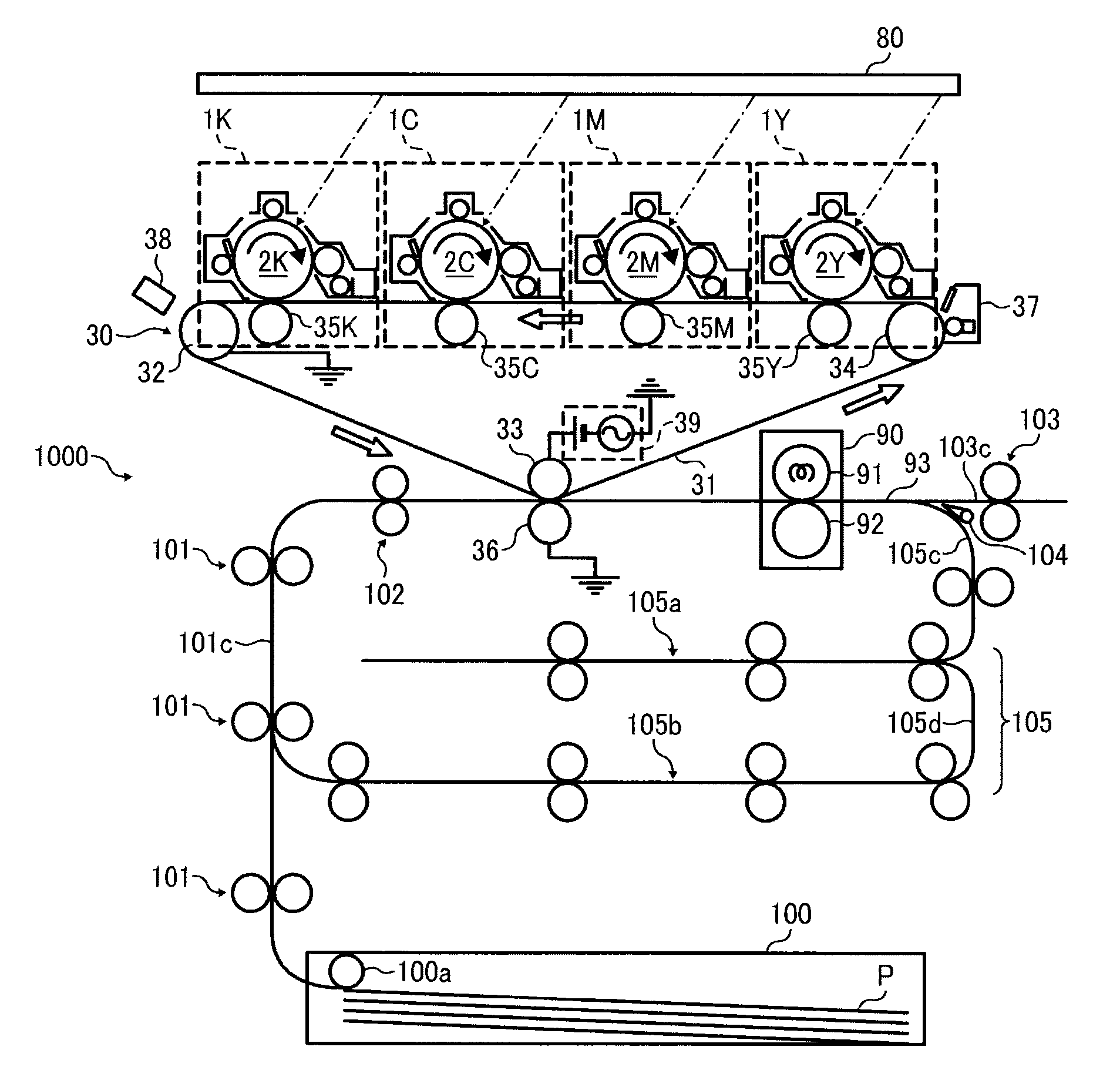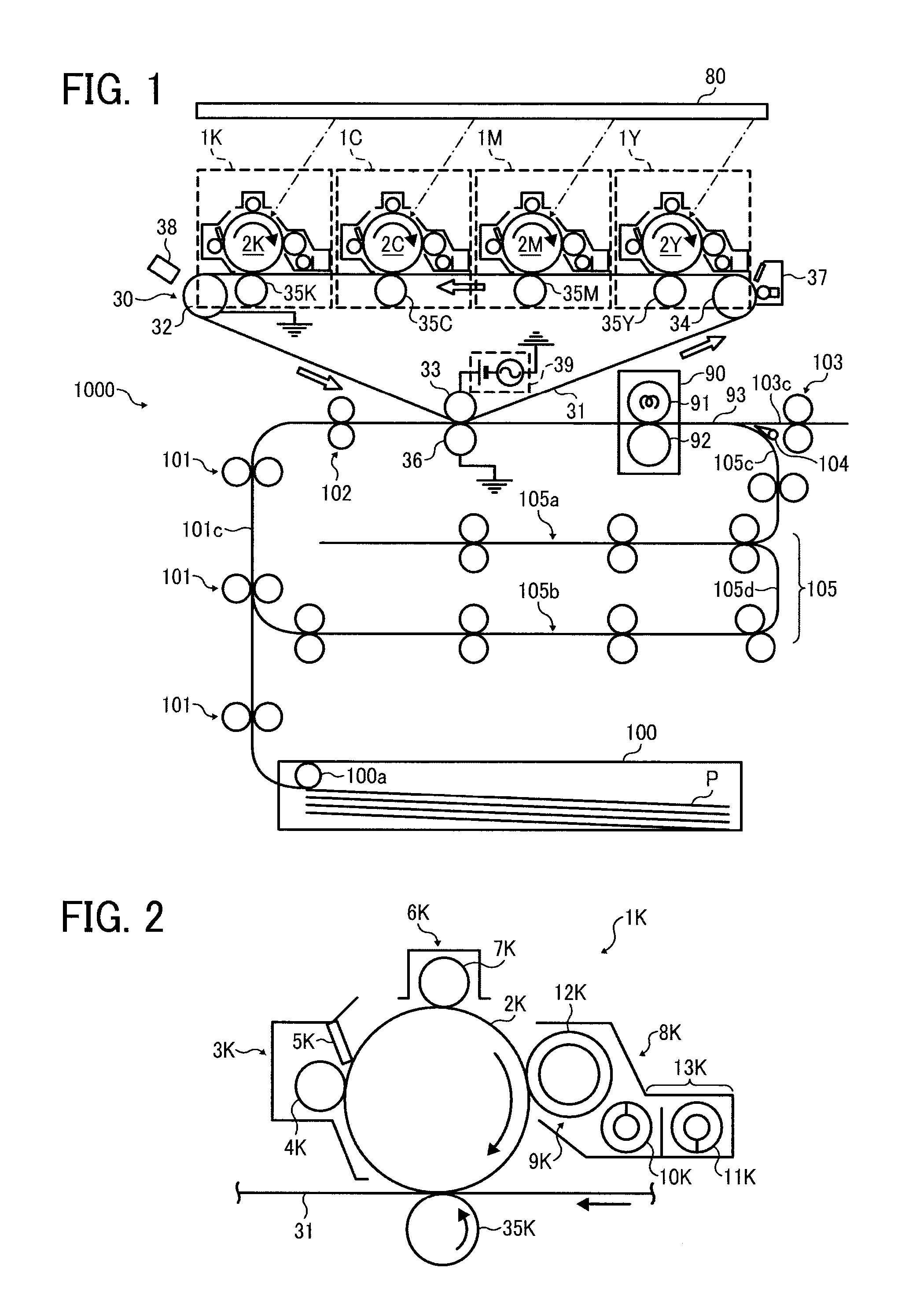Image forming apparatus
a technology of image forming apparatus and forming plate, which is applied in the direction of electrographic process apparatus, instruments, optics, etc., can solve the problems of insufficient image density, easy generation of toner scattering and insufficient image density, and inability to prevent the generation of white dots
- Summary
- Abstract
- Description
- Claims
- Application Information
AI Technical Summary
Benefits of technology
Problems solved by technology
Method used
Image
Examples
experiment 1
[Experiment 1]
[0102]The inventors prepared a printer having the same configuration as that of the above-described image forming apparatus 1000. The inventors carried out various types of print tests using the printer. In the experiment 1, the process linear velocity is set to 352 [mm / s]. As the recording sheet P, A4 sized paper (wood-free paper, My Paper manufactured by NBS Ricoh) is used.
[0103]In the experiment 1, the single magenta color solid image is formed on the respective first side and the second side of recording medium in the duplex printing mode, under normal experimental laboratory conditions (temperature 23° C. and humidity 50%). At this time, as the DC bias is applied as the transfer bias to both the first side and the second side, the DC bias is gradually increased in a range of from −1 [kV] to −6 [kV] in 0.1 [kV] increments, and the duplex print is performed at the respective voltage values. Then, the magenta single color solid image formed on the second side of the ...
experiment 2
[Experiment 2]
[0108]The toner scattering around the solid image and white dots in the solid image were evaluated under conditions of low temperature and low humidity (temperature: 10° C., humidity: 15%).
[0109]FIG. 5 illustrates the result in the experiment 2. More specifically, FIG. 5 illustrates the relation between the voltage of the secondary transfer bias and the evaluation grade of the white dots and the toner scattering, obtained from the experiment 2. As illustrated in FIG. 5, if focusing on only the toner scattering, by setting the DC bias (absolute value) less than −4.2 [kV], the toner scattering can be evaluated as an acceptable level of grade 4 or 5.
[0110]By contrast, if focusing on only the white dots, by setting the DC bias (absolute value) greater than −5.9 [kV], the white dots can be evaluated as an acceptable level of grade 4 or 5.
[0111]However, the voltage value that fulfills both toner scattering and the white dots over grade 4 does not exist. This is because, at l...
experiment 3
[Experiment 3]
[0113]In the experiment 3, the process linear velocity is set to 352 [mm / s]. As the recording sheet P, A4 sized paper (wood-free paper, My Paper manufactured by NBS Ricoh) is used. The single magenta color solid image is formed on the respective first side and the second side of recording medium in the duplex printing mode, under the ambient in the experimental laboratory is set under conditions of low temperature and low humidity (temperature: 10° C., humidity: 15%)
[0114]As for the power supply 39 to generate a voltage, a function generator (FG300 Yokogawa Electric Corporation) is used to create a waveform, and the voltage is amplified by a factor of 1000 by an amplifier (Trek High Voltage Amplifier Model 10 / 40). As the transfer bias, a superimposed bias in which the AC voltage whose frequency is 500 [Hz] and the peak-to-peak voltage Vpp is 6 [kV] is superimposed on the offset voltage Voff as the DC voltage is used. The superimposed is gradually increased in a range o...
PUM
 Login to View More
Login to View More Abstract
Description
Claims
Application Information
 Login to View More
Login to View More - R&D
- Intellectual Property
- Life Sciences
- Materials
- Tech Scout
- Unparalleled Data Quality
- Higher Quality Content
- 60% Fewer Hallucinations
Browse by: Latest US Patents, China's latest patents, Technical Efficacy Thesaurus, Application Domain, Technology Topic, Popular Technical Reports.
© 2025 PatSnap. All rights reserved.Legal|Privacy policy|Modern Slavery Act Transparency Statement|Sitemap|About US| Contact US: help@patsnap.com



